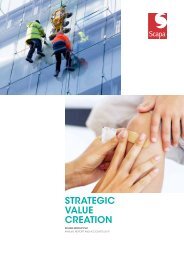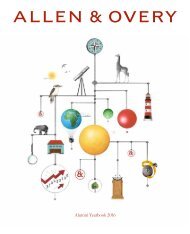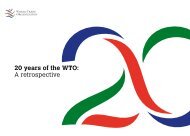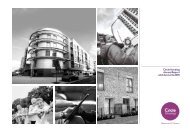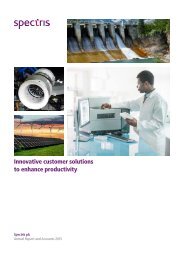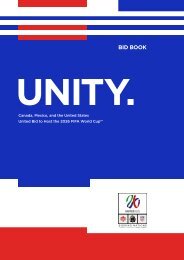QinetiQ Annual Report 2017
Create successful ePaper yourself
Turn your PDF publications into a flip-book with our unique Google optimized e-Paper software.
108<br />
108<br />
Financial<br />
Financial statements<br />
statements <strong>QinetiQ</strong><br />
<strong>QinetiQ</strong> Group<br />
Group<br />
plc<br />
plc<br />
<strong>Annual</strong><br />
<strong>Annual</strong><br />
<strong>Report</strong><br />
<strong>Report</strong><br />
and<br />
and<br />
Accounts<br />
Accounts<br />
<strong>2017</strong><br />
<strong>2017</strong><br />
www.qinetiq.com<br />
Notes to the financial statements continued<br />
1. Significant accounting policies continued<br />
Intangible assets<br />
Intangible assets arising from business combinations are recognised at fair value and are amortised over their expected useful lives, typically between one<br />
and sixteen years. Internally generated intangible assets are recorded at cost, including labour, directly attributable costs and any third-party expenses.<br />
The ‘multi-period excess earnings’ method and the ‘relief-from-royalty’ method are both used for fair valuing intangible assets arising from acquisitions. The multiperiod<br />
excess earnings method considers the present value of net cash flows expected to be generated by customer relationships, by excluding any cash flows<br />
related to contributory assets. The relief-from-royalty method considers the discounted estimated royalty payments that are expected to be avoided as a result<br />
of the patents or trademarks being owned.<br />
Purchased intangible assets are recognised at cost less amortisation. Intangible assets are amortised over their respective useful lives on a straight-line basis<br />
as follows:<br />
Intellectual property rights<br />
Customer relationships<br />
Development costs<br />
Other<br />
2–8 years<br />
1–16 years<br />
1–4 years<br />
1–9 years<br />
Property, plant and equipment<br />
Property, plant and equipment are stated at cost less depreciation. Freehold land is not depreciated. Other tangible non-current assets are depreciated<br />
on a straight-line basis over their useful economic lives to their estimated residual value as follows:<br />
Freehold buildings<br />
Leasehold land and buildings<br />
Plant and machinery<br />
Fixtures and fittings<br />
Computers<br />
Motor vehicles<br />
20–25 years<br />
Shorter of useful economic life and the period of the lease<br />
3–10 years<br />
5–10 years<br />
3–5 years<br />
3–5 years<br />
Assets under construction are included in property, plant and equipment on the basis of expenditure incurred at the balance sheet date. In the case of assets<br />
constructed by the Group, the value includes the cost of own work completed, including directly attributable costs and interest.<br />
The useful lives, depreciation methods and residual values applied to property, plant and equipment are reviewed annually and, if appropriate, adjusted accordingly.<br />
Impairment of goodwill and tangible, intangible and held for sale assets<br />
At each reporting date the Group assesses whether there is an indication that an asset may be impaired. If the carrying amount of any asset exceeds its<br />
recoverable amount an impairment loss is recognised immediately in the income statement. In addition, goodwill is tested for impairment annually irrespective<br />
of any indication of impairment. If the carrying amount exceeds the recoverable amount, the respective asset or the assets in the cash-generating unit (CGU) are<br />
written down to their recoverable amounts. The recoverable amount of an asset or CGU is the higher of its fair value less costs to sell and its value in use. The value<br />
in use is the present value of the future cash flows expected to be derived from an asset or CGU calculated using an appropriate pre-tax discount rate. Impairment<br />
losses are expensed to the income statement.<br />
Investments in debt and equity securities<br />
Investments held by the Group are classified as either a current asset or as a non-current asset and those classified as available-for-sale are stated at fair value,<br />
with any resultant gain or loss, other than impairment losses, being recognised directly in equity. When these investments are derecognised, the cumulative gain<br />
or loss previously recognised directly in equity is recognised in the income statement.<br />
The fair value of quoted financial instruments is their bid price at the balance sheet date. The fair value of unquoted equity investments is based on the price<br />
of the most recent investment by the Group or a third party, if available, or derived from the present value of forecast future cash flows.<br />
Inventories<br />
Inventory and work-in-progress are stated at the lower of cost and net realisable value. Work-in-progress and manufactured finished goods are valued at production<br />
cost. Production cost includes direct production costs and an appropriate proportion of production overheads. A provision is established when the net realisable<br />
value of any inventory item is lower than its cost. A ‘market comparison’ technique is used to fair value inventories acquired through a business combination. The<br />
fair value is determined based on the estimated selling price in the ordinary course of business less the estimated costs of completion and sale, and a reasonable<br />
profit margin based on the effort required to complete and sell the inventories.<br />
Bid costs<br />
Costs incurred in bidding for work are normally expensed as incurred. In the case of large multi-year government contracts the bidding process typically involves a<br />
competitive bid process to determine a preferred bidder and then a further period to reach financial close with the customer. In these cases, the costs incurred after<br />
announcement of the Group achieving preferred bidder status are deferred to the balance sheet within work-in-progress. From the point financial close is reached,<br />
the costs are amortised over the life of the contract. If an opportunity for which the Group was awarded preferred bidder status fails to reach financial close, the<br />
costs deferred to that point are expensed in the income statement immediately, when it becomes likely that financial close will not be achieved.<br />
Trade and other receivables<br />
Trade and other receivables are stated net of provisions for doubtful debts. Amounts recoverable on contracts are included in trade and other receivables<br />
and represent revenue recognised in excess of amounts invoiced. Payments received on account are included in trade and other payables and represent<br />
amounts invoiced in excess of revenue recognised. Other receivables will also include insurance recoveries where we are virtually certain of recovery.




